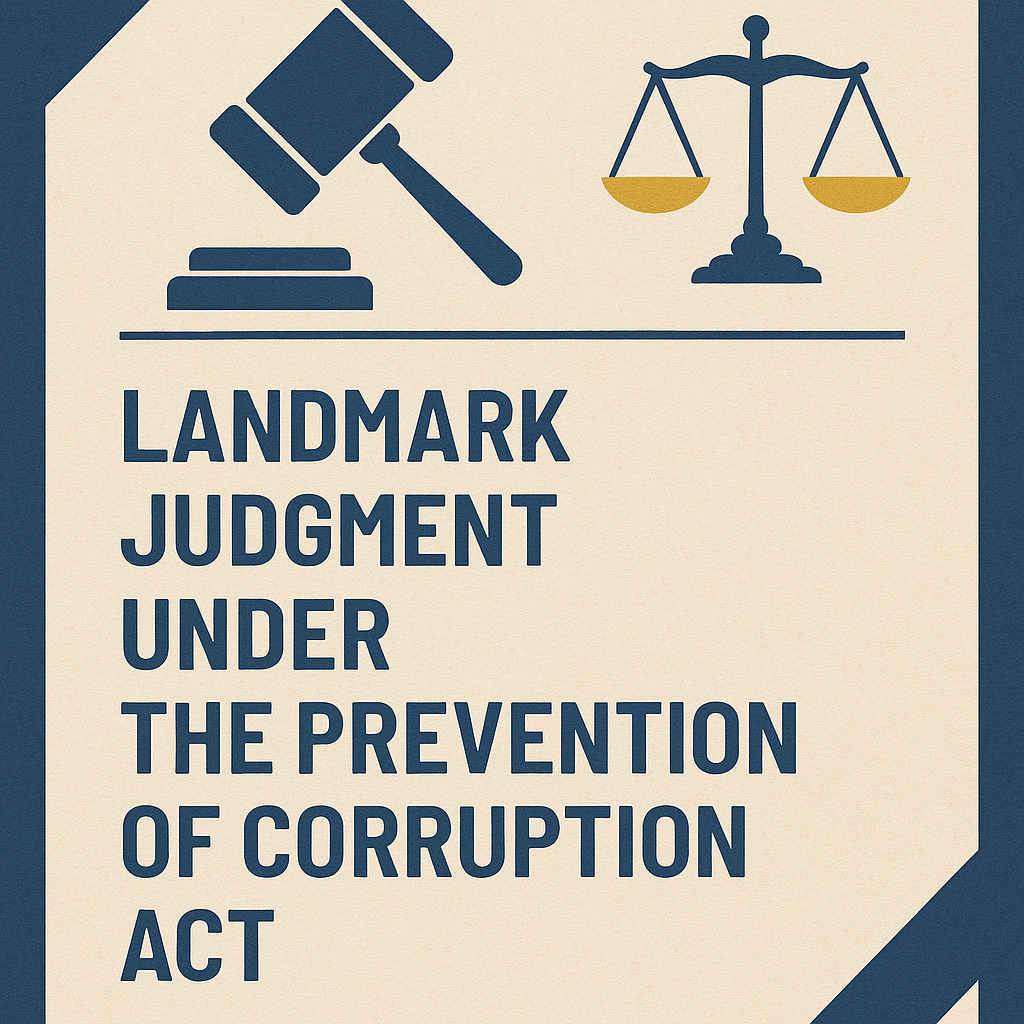View News
Landmark-Judgment-under-the-Prevention-of-Corruption-Act-A-Legal-Analysis

Landmark Judgment under the Prevention of Corruption Act: A Legal Analysis
Introduction
Corruption has long plagued India's administrative and governance systems, threatening transparency, fairness, and economic progress. In this context, the Prevention of Corruption Act, 1988 (hereinafter "PC Act") is a cornerstone legislation aimed at combating corrupt practices in public life. Over the years, numerous judgments have shaped the interpretation and application of this Act. Among them, the Supreme Court’s judgment in Subramanian Swamy v. Manmohan Singh & Anr., (2012) 3 SCC 64 stands out as a landmark in streamlining prosecution under the PC Act, especially against public servants.
This article delves into the detailed analysis of this seminal judgment, its background, legal issues, reasoning, and implications on India’s anti-corruption framework.
I. Legislative Background of the Prevention of Corruption Act
The PC Act, 1988 was enacted to consolidate and amend the law relating to the prevention of corruption among public servants. It defines various offenses including:
-
Accepting bribes (Section 7),
-
Criminal misconduct (Section 13),
-
Abuse of official position,
-
Possession of disproportionate assets (Section 13(1)(e)).
The Act mandates prior sanction for prosecution of public servants under Section 19, which is often invoked as a shield by the accused, sometimes delaying or stalling investigation or prosecution.
II. Case Background: Subramanian Swamy v. Manmohan Singh & Anr.
Facts of the Case
In this case, Dr. Subramanian Swamy, a politician and activist, filed a petition seeking prosecution of the then Union Minister of Communications and IT, Mr. A. Raja, under the PC Act for alleged irregularities in the allocation of 2G Spectrum licenses in 2008.
Dr. Swamy submitted a representation to the then Prime Minister, Dr. Manmohan Singh, on 29 November 2008, seeking sanction under Section 19 of the PC Act to prosecute Mr. Raja. However, for almost 16 months, there was no decision taken. Dr. Swamy contended that this inordinate delay in granting or refusing sanction was unjustifiable and amounted to dereliction of constitutional duty.
He approached the Supreme Court under Article 32 of the Constitution, alleging violation of his right to obtain sanction for prosecuting a public servant.
III. Key Legal Questions Before the Supreme Court
-
Whether the competent authority (in this case, the Prime Minister’s Office) can indefinitely delay granting or refusing sanction under Section 19 of the PC Act?
-
Whether the right to file a complaint under the PC Act against a public servant is hindered by the inaction or delay of the sanctioning authority?
-
Does such delay in granting sanction defeat the very purpose of anti-corruption laws?
IV. Analysis and Judgment by the Supreme Court
The Bench comprising Justice G.S. Singhvi and Justice A.K. Ganguly delivered a unanimous verdict on 31 January 2012, addressing the malaise of delayed sanction and the constitutional duty of authorities in such cases.
1. Right to Seek Sanction
The Court recognized the right of a citizen to file a complaint and seek sanction as a constitutional guarantee rooted in the Rule of Law. It stated:
“Anyone can set the criminal law in motion... The citizen's right to file a complaint cannot be frustrated by inaction of the sanctioning authority.”
Thus, it recognized the citizen’s locus standi in initiating criminal prosecution under anti-corruption laws.
2. Unreasonable Delay is Impermissible
The Court held that:
-
Sanction under Section 19 is not a mere formality, but must be granted or refused in a time-bound manner.
-
Authorities must exercise discretion in a reasonable time frame, preferably within 3 months from the date of request.
-
If consultation is required with the legal department, a further period of 1 month can be allowed.
It emphasized:
“In all cases, the sanctioning authority is under a legal duty to take an appropriate decision within this time frame.”
3. Consequences of Delay
If sanction is deliberately or unduly delayed, it could lead to:
-
Frustration of the prosecution process,
-
Encouragement of impunity,
-
Breach of public trust.
The Court observed that such delay could be challenged under judicial review, and courts may intervene to ensure accountability.
4. Constitutional Morality
Justice Ganguly in his concurring opinion observed that:
“Corruption is not only a punishable offense under law; it is an assault on human rights and constitutional values.”
The delay in deciding on sanction undermines constitutional morality and the citizen’s faith in the justice system.
V. Implications of the Judgment
This verdict had a far-reaching impact on the prosecution of public servants under the PC Act and the governance standards in India. Here are the major takeaways:
1. Time-Limit for Grant of Sanction
The most significant takeaway is the judicially prescribed time-limit of three months (extendable to four) for deciding sanction. While not part of the statute, this direction has become an administrative guideline that authorities are expected to follow.
2. Curtailing Executive Delays
The judgment checks the executive’s discretionary delay and potential misuse of power to protect or delay action against erring officials.
3. Empowering the Citizens
It empowers citizens, activists, and whistleblowers by recognizing their right to initiate criminal action, thus making governance participatory and accountable.
4. Strengthening Judicial Oversight
The verdict underscores the judicial role in overseeing administrative inaction and ensuring that sanction is not misused to shield corruption.
VI. Related Judicial Precedents and Statutory Amendments
A. Other Notable Judgments
-
Manohar Lal Sharma v. Principal Secretary (2014) – In the context of the Coal Scam, the Court reiterated the principle that sanction should not be unduly delayed and authorities should be accountable.
-
CBI v. Ashok Kumar Aggarwal (2013) 15 SCC 222 – The Court held that a trial can be quashed if sanction is deliberately delayed, defeating the purpose of the PC Act.
B. Statutory Amendments: 2018 Amendment to PC Act
In 2018, the PC Act was significantly amended to align with the UNCAC (United Nations Convention Against Corruption). The key changes include:
-
Introduction of Section 17A: Prior approval of the appropriate government is now required before initiating any inquiry/investigation against a public servant.
-
Redefining "Criminal Misconduct": Now limited to two categories—misappropriation of property and possession of disproportionate assets.
While these changes streamline the law, critics argue that Section 17A introduces a new layer of sanction, potentially diluting the spirit of the Swamy judgment.
VII. Criticism and Counterviews
While the judgment has been largely appreciated, some concerns remain:
-
Executive Overreach: Some argue that requiring sanction from the executive may itself be flawed, as it involves judging its own members.
-
Chilling Effect on Public Servants: Others fear that easy prosecution without robust safeguards may deter honest decision-making.
However, the judgment carefully balanced these concerns by mandating expeditious decision-making, not removing the sanction requirement altogether.
VIII. Comparative Perspective
United Kingdom
The UK Bribery Act, 2010 does not require prior sanction to prosecute public officials, reflecting a more direct approachto corruption.
United States
In the U.S., prosecuting public servants is subject to the same rules as any other individual, indicating no special privilege of sanction.
Thus, the Indian system’s requirement of sanction is unique and requires judicial oversight like the one exercised in the Swamy case.
IX. Conclusion
The Supreme Court’s judgment in Subramanian Swamy v. Manmohan Singh is a cornerstone in India’s fight against corruption. It reaffirms the citizen’s role, restricts executive delay, and aligns administrative discretion with constitutional responsibility.
The Court's interpretation of the PC Act not only enhances transparency and accountability in governance but also sets a precedent for judicial activism to uphold the Rule of Law.
In an era where public trust is critical, this judgment reminds us that combating corruption is not just a legal requirement—it is a democratic imperative.
References
-
Subramanian Swamy v. Manmohan Singh & Anr., (2012) 3 SCC 64
-
Prevention of Corruption Act, 1988 (as amended in 2018)
-
Article 32, Constitution of India
-
CBI v. Ashok Kumar Aggarwal, (2013) 15 SCC 222
-
Manohar Lal Sharma v. Principal Secretary, (2014) 9 SCC 516
-
UN Convention Against Corruption (UNCAC)
"Unlock the Potential of Legal Expertise with LegalMantra.net - Your Trusted Legal Consultancy Partner”
Disclaimer: Every effort has been made to avoid errors or omissions in this material in spite of this, errors may creep in. Any mistake, error or discrepancy noted may be brought to our notice which shall be taken care of in the next edition In no event the author shall be liable for any direct indirect, special or incidental damage resulting from or arising out of or in connection with the use of this information Many sources have been considered including Newspapers, Journals, Bare Acts, Case Materials , Charted Secretary, Research Papers etc.

